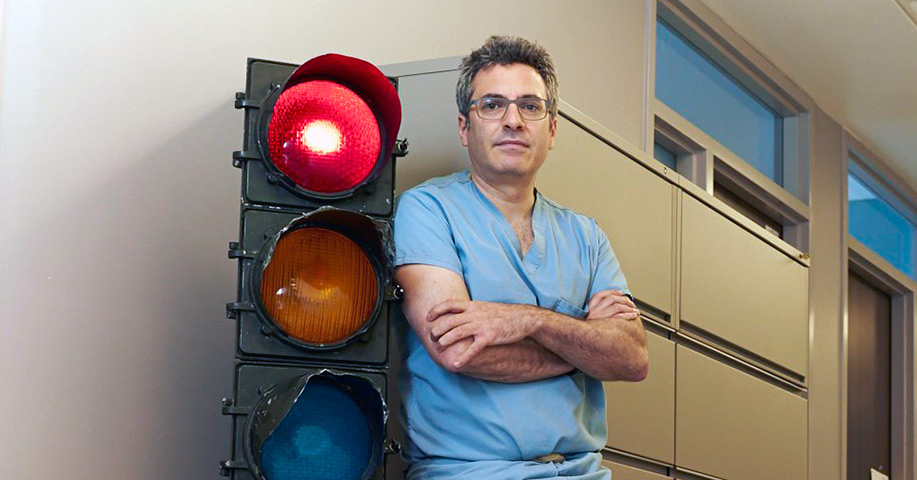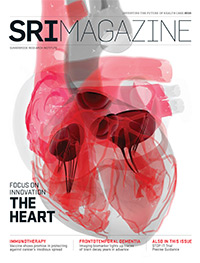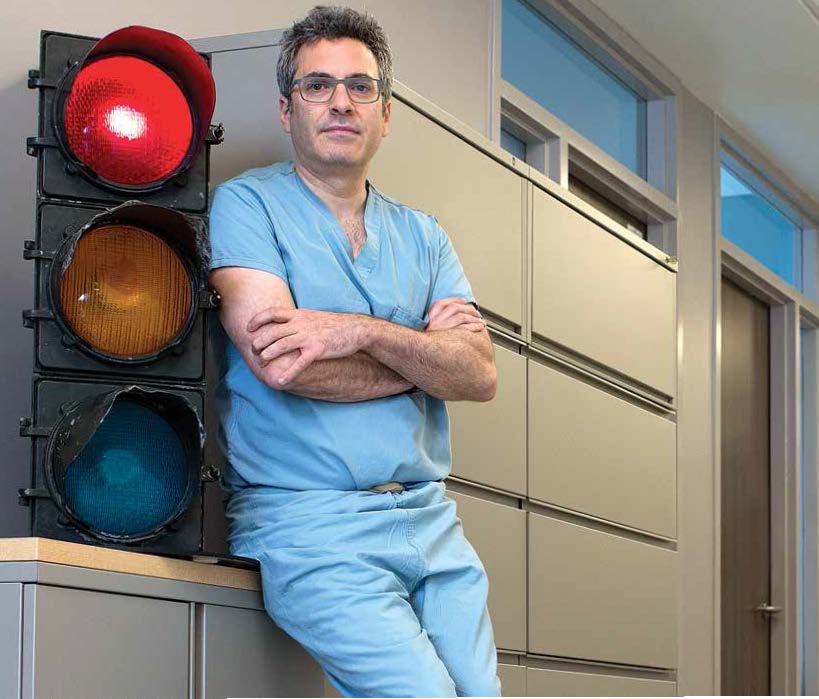STOP-IT Trial Shows Short Course of Antibiotics Safe for Treating Intra-Abdominal Infections
Results also relevant to global health effort to halt the overuse of antibiotics
June 15, 2015

Sunnybrook’s surgeon-in-chief Dr. Avery Nathens sees a lot of intra-abdominal infections in his operating room. He was the Canadian lead on a large, multicentre trial that found shorter courses of antibiotics are safe and effective.
Too much of a good thing can be a bad thing, especially if the good thing is antibiotics. The overprescription of antibiotics is the main factor driving a worldwide increase in antimicrobial resistance, which poses a serious threat to global public health. On an individual level, prolonged exposure to antibiotics disturbs the resident gut flora—the community of beneficial bacteria living in your gut—and is associated with a number of ailments, including an increased risk of Clostridium difficile infection.
Intra-Abdominal Infections
- Intra-abdominal infections are the second most common cause of death from infectious disease in intensive care units in the U.S.
- Appendicitis is the leading cause of inpatient hospitalization in Canada (excluding maternal cases) among people aged 19 to 44.
- Globally, intra-abdominal infections cause one in four cases of severe sepsis, a life-threatening, whole-body inflammatory attack.
- 80% to 90% of intra-abdominal infections are caused by an infection that has spread from the gastrointestinal tract via a perforation caused by disease or trauma. Of these, 70% are community-acquired and 30% are hospital-acquired.
- By 2050, antimicrobial resistance is predicted to lead to 10 million extra deaths annually and cost the global economy up to $100 trillion USD.
In an ideal world, patients would stop taking antibiotics as soon as their bacterial infections are resolved. In reality, antimicrobial therapy is often extended longer than necessary for the doctors’ and patients’ peace of mind.
When it comes to managing an intra-abdominal infection, there is no clear consensus on what is the optimal length of antimicrobial therapy. “Some surgeons think everyone needs to be on [antibiotics] for as long as two weeks, while others believe that they can discontinue antibiotics once patients have improved clinically,” says Dr. Avery Nathens, program research director of the Tory Trauma Program at Sunnybrook Research Institute and surgeon-in-chief at Sunnybrook. “Up until recently, there hasn’t been any evidence to guide us one way or another.”
Guidelines for the management of intra-abdominal infections recommend patients take antibiotics until clinical symptoms are resolved and sustaining the treatment for two days thereafter. However, several smaller studies suggest that with adequate control of the infection, or “source control” as it is called, shorter courses of antibiotics might be sufficient to cure the infection while decreasing the risk of antimicrobial resistance.
Source control for intra-abdominal infections is typically achieved in the operating room. Intra-abdominal infections usually result from a perforation of the gastrointestinal (GI) tract, with common causes being a ruptured appendix or a perforated ulcer. An infection becomes complicated when it spreads beyond the infected organ to cause inflammation in the peritoneum, the thin layer of tissue lining the abdominal cavity. Surgery is required to patch the hole, drain the abscess, or in severe cases remove the damaged portion of the GI tract and reroute bowel contents. These interventions aim to remove the source of infection and restore normal physiological function to the gut. As Nathens notes, these procedures make up the bread and butter of a general surgeon’s practice. “[Surgery] probably takes care of 99.9% of all the [bacteria] that are present,” he says. “And the issue is, well, now that we have accomplished source control, how long do they need to be treated with antibiotics?”
Enter the Study To Optimize Peritoneal Infection Therapy, the STOP-IT trial. In collaboration with colleagues from Canada and the U.S., Nathens designed the STOP-IT trial to test whether a short, fixed duration of antibiotic therapy would lead to equivalent outcomes as the traditional strategy of prolonging antibiotic treatment to two days after resolution of symptoms.
The study recruited 518 patients with complicated intra-abdominal infections, all of whom underwent the appropriate surgical intervention to achieve adequate source control. The patients were randomly assigned to one of two groups. The experimental group received four days of antibiotics following their source control procedure. The control group received antibiotics until their symptoms were gone and were kept on antibiotics for two days after that, for up to 10 days.
Patients in the control group received, on average, eight days of antimicrobial therapy, whereas patients in the experimental group received four. Despite the difference in therapy duration, both groups had similar rates of surgical site infection and recurrent intra-abdominal infection.
Nathens, who is also a professor in the department of surgery at the University of Toronto, was not surprised by these findings, which were published in the New England Journal of Medicine. “When you look at the smaller studies, many of which were not randomized, there was a hint that you would probably be fine with a shorter duration of therapy,” he says. “This study provides us with fairly high-level evidence that shorter courses of treatment appear to be safe.”
Although the rates of recurrent infection were similar between groups, the infections were diagnosed much later in the control group. Nathens believes that the longer treatment of antibiotics helped to hide the recurrent infection by managing some of the symptoms, such as fever. For a recurrent infection, he says, antibiotics are not effective, and surgical interventions are usually required to eliminate the source. Thus, the longer course of antibiotics might actually hinder the recovery process by delaying the diagnosis and proper treatment of recurrent infections.
Given the paucity of large, randomized controlled trials for the treatment of intra-abdominal infections, Nathens is optimistic that the STOP-IT trial will have a significant impact on clinical guidelines and help standardize practice. Moreover, he says he hopes studies such as this will facilitate dialogue between doctors in the infectious disease and surgical communities and patients on what an appropriate course of antibiotics might be.
“The patient’s perspective is that more antibiotics is better, but we try to emphasize that it’s probably not a good thing if you don’t need them,” says Nathens. “We feel more comfortable now in speaking with them and explaining that fewer days of antibiotics is actually the preferred approach, with no adverse outcomes associated with this strategy.”
This study was funded by the National Institutes of Health.




